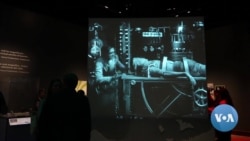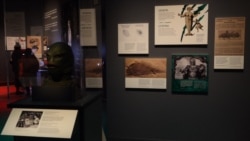Dracula, Frankenstein and other monsters may have literary origins, but Hollywood has turned them into iconic characters that have scared and thrilled audiences for decades.
In the new exhibit, “Natural History of Horror,” the Natural History Museum of Los Angeles County explains the link between art and reality, and shows how filmmakers looked to science and archeology as inspiration for hair-raising movie monsters.
“It’s really been a journey since those films were created to see how these different monsters have been interpreted and reinterpreted over the years,” said Jeff Pirtle, director of archives and collections, at NBC Universal.
“When you look at, for instance, Dracula, all you have to do is see a man in a cape and a tuxedo underneath -- it’s an iconic image," said Beth Werling, collections manager in the museum's history department. "You know, it’s the suave, sophisticated Dracula during the day, and a vampire at night. You look at Frankenstein and the green makeup and the flat head and the bolts coming out of the neck, you know what you’re looking at.”
Visitors can see original monster movie posters and props donated by Universal, including the ball and chain that shackled Frankenstein’s reanimated corpse in the 1931 movie.
There is also a reproduction of the costume from the 1954 film "Creature from the Black Lagoon," with movable gills.
Beyond the props, the exhibit highlights the real-life inspirations for the Hollywood horrors.
Milicent Patrick designed the “creature” from the Black Lagoon by studying reptiles, amphibians, fish and pictures of extinct animals. One of the creature's origins came from the discovery in 1938 of coelacanths — fish that some biologists thought at the time to be the missing link between sea and land creatures.
The discovery of King Tutankhamun's tomb in 1922 inspired "The Mummy" in 1932. In the new exhibit, the wrappings of a real mummy are displayed near fake wrappings from the movie.
“The prop is pretty much what the originals were made out of — linen cloth, very coarsely woven. And in our case, with the prop mummy wrappings, they were dubbed with Fuller’s earth (clay material) to give them the kind of dusty, crusty look to age them," Werling said. Fuller's earth is "kind of like a dirt-like mixture that you would use when you wanted to age something or have something look dusty. As a matter of fact, it was used also in the makeup for Boris Karloff in 'The Mummy.' "
For Dracula, the prop for the vampire bat is on display, along with a real bat and information on how Europeans used to think vampires caused various types of diseases.
The monsters may look different and have different origins, but they share a common thread in the horror films.
“What it really encompasses is characters that all they really want is to be loved," Pirtle said. "Because you see Dracula, you see Frankenstein, you see the Mummy, you see the bride of Frankenstein, and it's characters that just want to be accepted. And I think that’s just a universal theme that audiences identify with.”
Love and acceptance may explain why filmmakers keep making movies inspired by these Hollywood horrors.
“Natural History of Horror” is on display now until April 19, 2020.







